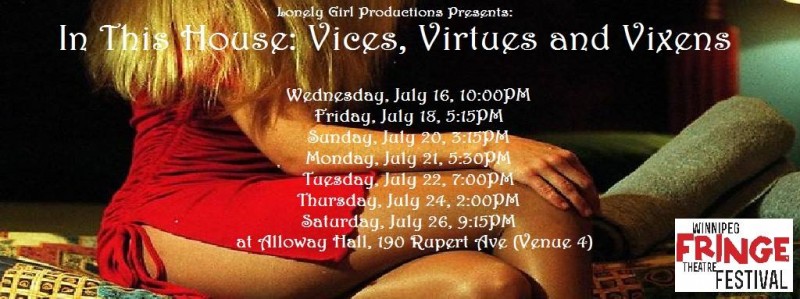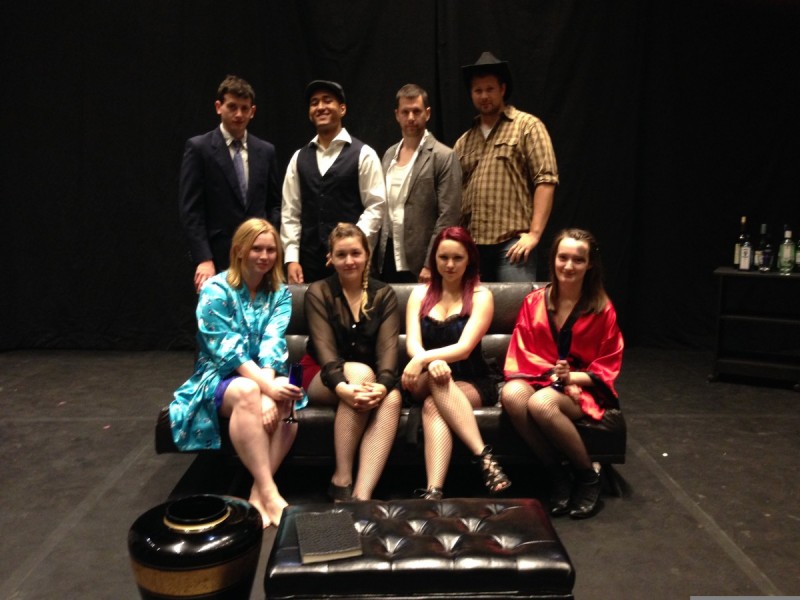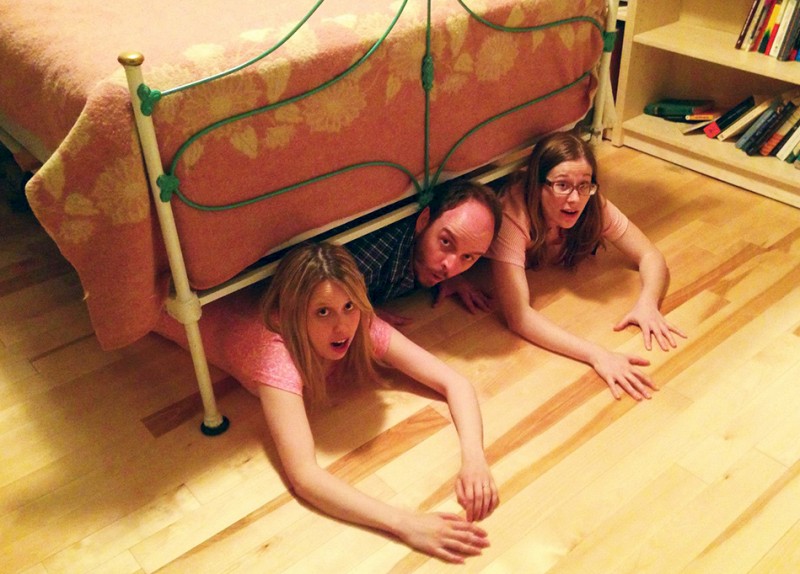
There's someone under the bed: The cast of Wang Dang.
More UM Winnipeg Fringe Festival fun
From vice and vixens to the embarrassing ordeals of 'ontological insecurity'
In This House: Vices, Virtues and Vixens is set in the fictional location of Crown City, where a high-end brothel operating under the guise of a theatre company gets quite a shock when it’s revealed that one of the girls is expecting. The play’s story is framed by Magdalene telling stories to a pregnant Rosella in the present, while most of the play’s action takes place almost 20 years in the past. Magdalene takes part in this action while Rosella acts as an onlooker.
 Written by Faculty of Arts student Shaylyn Maharaj-Poliah, Vices, Virtues and Vixens was inspired by a desire to create “an understanding of the challenges, sacrifices and difficult choices” faced by women in the sex trade.
Written by Faculty of Arts student Shaylyn Maharaj-Poliah, Vices, Virtues and Vixens was inspired by a desire to create “an understanding of the challenges, sacrifices and difficult choices” faced by women in the sex trade.
The main dramatic action turns on how other women have dealt with this kind of situation in the past, says Maharaj-Poliah. Rosella has to make a choice determining her own fate and that of her unborn child.
And just when you think that everything’s been resolved, there’s a plot twist — “the heart and soul of the play is most evident at that moment,” says the playwright.
What inspired her to tackle the subject matter?
“As a young woman, I feel blessed by the opportunities I have had in my life,” she explains. “Unfortunately, there are a lot of females in the world who have not been given similar opportunities. I wanted to create something that would touch the heart and the mind while still offering some humorous respite.”

The cast of In this House: Vices, Virtues and Vixens. Back row (L to R): Loren MacDonald, Jeremy Zloty, Ian Bastin, Jayse Meyer. Front row (L to R): Kat Petrash, Kaeleigh Ayre, Renata Echtenkamp, Lindsay Bodnar. // Photo Shaylyn Maharaj-Poliah
Her favourite scene includes an intense, high energy fight that comes near the end of the play. “It’s also very technical and it took a lot of work from both [actors] Jeremy Zloty and Ian Bastin to make it look spontaneous and real,” she says.
That, she adds, is immediately followed by a “very tender and gentle moment between Mink, played by Jeremy Zloty, and Magdalene, played by Renata Echtenkamp…. No words spoken but its meaning is loud and clear. I know it had some audience members tearing up on opening night.”
The playwright’s favourite scene: “No words spoken but its meaning is loud and clear.”
For the playwright, working with a passionate, invested cast has been exciting. Says Maharaj-Poliah, “They all had to really stretch in these roles because they’re so opposite to who they really are. I don’t want the audience coming in expecting to see something dark and depressing. While those elements are there, it is balanced by a good amount of humour and sexual innuendo to keep things interesting.”
In this House: Vices, Virtues and Vixens is written and directed by Shaylyn Maharaj-Poliah, and is performed by the all Arts student cast of Kaeleigh Ayre, Jeremy Zloty, Ian Bastin, Renata Echtenkamp, Kat Petrash, Lindsay Bodnar, Jayse Meyer and Loren MacDonald.
***
Wang Dang
George Toles calls film actor and New York City playwright Tom Noonan “the playwright of ontological insecurity.”
The U of M film prof and longtime Guy Maddin collaborator is directing Noonan’s Wang Dang at this year’s Fringe, with a cast that includes alumni Ivan Henwood, Jane Walker (both of Snakeskin Jacket) and Kerri Wolosyzn. The stage manager is alumna Carol Moriyama.
The main character is an independent movie maker down on his luck, says Toles, “visiting a campus to give one of his probably not-very-good talks in his lecture circuit on film making. Two young women, both of whom have film making ambitions, drop by … his motel room and the possibility of a three-way comes into focus but the reasons why it may not happen — the respective game plans, delusions and moment-to-moment ordeals — are also there to either amplify or reduce the premise,” he laughs.
The director describes Noonan as “maybe the foremost theatre specialist in the varieties of embarrassment, mortification and passive-aggression,” someone who “knows how to combine them in expert, soul-grinding ways.”
Noonan’s approach makes him unique. “Every moment in this play is an ordeal for people to get through, says Toles. “I mean, with other playwrights, well, maybe a scene is an ordeal, or maybe a long conversation is an ordeal — but Noonan understands that each and every moment is a trial.
Toles: “Noonan understands that each and every moment is a trial.”
“And he manages to describe these trials in a way that is both accurate and very funny — but things can turn dire on a dime. For these and other reasons, I like him,” says Toles.
It’s a dialogue-driven play — “in fact, one of the characters, talking conceivably about work like Noonan’s own, says, ‘I’ve got an idea. Why don’t we just have, like in the first part of your movie … [where] people talk a lot until they get that out of their system and they’ve finished talking, someone kills them all — and there’ll be blood everywhere …’
“And director/playwright listens and thinks that might be a good idea,” he laughs.
“But I’m not going to tell you whether, in fact, the stage ends up bloodied.”
***
The cast

The cast of Wang Dang. Toles: “The photo was an attempt to suggest the childhood game aspect of it, in a manner that doesn’t leave the bed out of consideration.”
Noonan has said that this play was his attempt to do a play about children — though none appear onstage. But, says Toles, “the idea of the child in all its both blessed and terrifying dimensions is central to the play, and the women certainly fall under the umbrella of some notion that [Noonan] has about children, and issues he has with children.”
Cast member Jane Walker, playing one of the aspiring women, also has the ability to bring the realm of the child into her roles, he says.
“Though the character she’s playing could be described … as a narcissist, the crucial child dimension that comes forward most strongly is something [Walker is] absolutely capable of tapping into and projecting, without the least bit of strain.”
How does Toles describe the cast as a whole? “Each of them are shy people for whom theatre provides a wonderful opportunity for self-transformation,” he says.
Toles: “[The cast members] are shy people for whom theatre provides a wonderful opportunity for self-transformation.”
“Ivan [Henwood], who is often — maybe most of the time — as saintly and considerate a person as I can think of, has a chance to unleash a squad of demons in this play,” he continues. “Kerri [Wolosyzn], very solid, considerate and completely unselfish within the normal realm, gets to play someone who is much harder a type, someone with eyes on the main chance who is not by any means awkward or unsure … and it seems to me that this particular persona suited Kerri better than any I’ve watched her work with in her previous theatre outings. The character that Jane [Walker] plays is a wild card that seems to be coming in from a separate planet. Jane has one of those faces that — everything — it’s just all there. I think that … in each role that she plays, the child is always close to the surface.”
Working with the cast he’s worked with previously (and as students) made for a very comfortable working relationship, he adds. “I had a very clear sense of how to communicate with each of them in terms of what their process is. I felt that we were singularly fortunate to find a play that suits the strengths of each of the actors.”
***
Surprise, surprise
The coup de théâtre, says Toles, happens in the scene that involves an interrupted dance to a strange piece of music.
This is not your usual dance scene indicating all will work out between the characters. “Let me just say that the dance ultimately does something rather different than dance scenes generally do. This will be the scene probably most talked about,” says Toles.
“I know that every director pushing for a show says this, how entertaining it’s going to be and how full of surprises, but I really do think that this is one where you could say, how many variations within the situation are possible? I, at least, as a first-time reader of the play, was taken utterly by surprise — and I’ve read a lot of plays — so with luck, some of our viewers will also be taken by surprise.”
–Mariianne Mays Wiebe
***
Check showtimes here — and see our previous Fringe story for more plays featuring UM students, staff, faculty and alumni.
Research at the University of Manitoba is partially supported by funding from the Government of Canada Research Support Fund.







